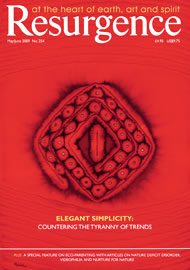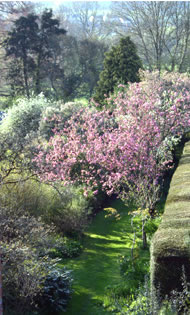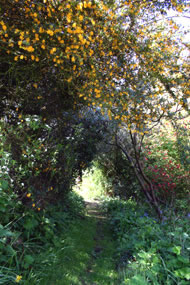THIS SUMMER THE garden has lived with us for twenty-five years. Arriving, I had no concept of such a continuum and felt perched in an environment shaped by predecessors familiar only in the imprint of hand, foot or psyche. The sandy soil breathed out the tilling of decades; now I suppose my print must be here, yet the garden is still not ‘mine’. The passing years have only emphasised the delicacy of the relationship, but have been long enough to see things develop or disappear, whether in their own time or sped on their way by human intervention. Since I have always been just one of many gardeners here, I owe a tribute to the events and the helping hands, paws and beaks that continually shape the garden.
When we took over the garden something of its 1920s’ grandeur still remained, with lawns, stone walls and paths, though the formality had been considerably softened by self-sowing: philadelphus had taken over a huge pile of rubble outside the back gate; flowering currant, berberis and cotoneaster appeared and took hold wherever possible, sown by birds who feast on the berries throughout the autumn. Squirrels spread hazels, japonica, winter honeysuckle and burnet rose marched through whole flower beds and golden rod and raspberries sprang up wherever conditions allowed.
An early visitor to the garden declared that a herbicidal spray throughout would be her solution, and though I was bewildered by the profusion I waited for decisiveness to be informed by spirit of place – and still wait – for I think this is the best gardening advice I have been given.
To begin with we thought garden help essential since a young family curtailed my time gardening. I was blessed with a keen-eyed man of the land whose labouring had come to an end after a serious accident in the construction of the nearby motorway. He could still hoe and dig, had eyes like a hawk, would spare any seedling he knew not to be a weed, and mark each planted row with some green whip cut from a shrub; many of the markers rooted! Consequently the vegetable garden sported poppies, mulleins and calendula, and I soon had a nursery bed of saplings and rooted cuttings.
He was followed by Joss, a man in his fifties who had come to gardening after abandoning a youthful desire to be a missionary. In the summer he would garden in his swimming trunks and would emerge from the shrubberies like Caliban from the wild wood. For Joss the garden was animated by plant and bird life; he knew how to attune himself to seasonal events, and smiled at clearing up after moles or small boys who had ‘rebuilt’ his log pile.
THE BIG EVENTS are the fall of trees: 1990 saw the crash of an ancient lime; with its eight or nine limbs separating low on the main trunk it fell easily, with the deepest slowest thud as a fierce storm tossed the greenhouse glass over the garden and wrenched limbs out of the hedgerow oaks. Nothing else could have had such an impact in so few hours, and it took months to come to terms with the wind’s day of play. Joss patiently cut away the crown which filled a shrubbery and lawn and barrowed away the branches; a great heap of twigs were shredded. Now several limes grow around the original stump, one showing promise as a structurally more stable heir. The hedgerow oaks have filled out again from their crowns and the greenhouse has been repaired, though now it is rather shaded by a Discovery apple tree whose potential I had quite misjudged.
Whereas wind is definitive in its action, other trees have succumbed through waterlogging. Much of the garden is on old water meadow, and the same slow thud woke me one still winter morning a few years later. A weeping ash beside the well had simply keeled over. Down at the bottom of the garden three old birches, declared mature by an admiring nurseryman when we arrived, still stand, their shallow roots spread wide. A young mulberry in full leaf blew over in a summer storm in 2004 and despite pruning and propping never recovered from having its main root broken.
An ancient, congested juniper became the perfect perch for a visiting eight-year-old girl who used to roost in it and command the other children to follow. This reduced the shrub to a mess of branches more dead than alive and its removal also evicted a long-established family of rabbits whose hold over the garden was then curtailed. I would not have had the courage to deliver the sentence; the children’s game did it for me.
One enduring feature I have come to appreciate is the grass path in the vegetable garden; it is easy to weed the edges when cultivating and it never needs cleaning, unlike the grander stone paths. I enjoy my husband’s talent for weeding by species, mostly just before flowering, when the plant is fully extended. Most people garden by sorting out an area for a visible impact, but he loves the foray and returns hot and happy with a barrow full of docks, goosegrass, sedge-grass and nettles.
Our garden was on the market for two years before we viewed it. The previous owners had been waiting for the right person and when I recognised the patch of trillium in the woodland, I knew they would sell to us. I have not been able to preserve every tiny treasure, though the trilliums have slowly spread, but I have shared slips and cuttings with other gardeners. I no longer look back at an unrecoverable past when paid gardeners edged lawns and hand-weeded alpines. I am now most happy looking at the soil: mulched, composted and forked over rather than dug, it is now darker, more fertile and endlessly promising. •








